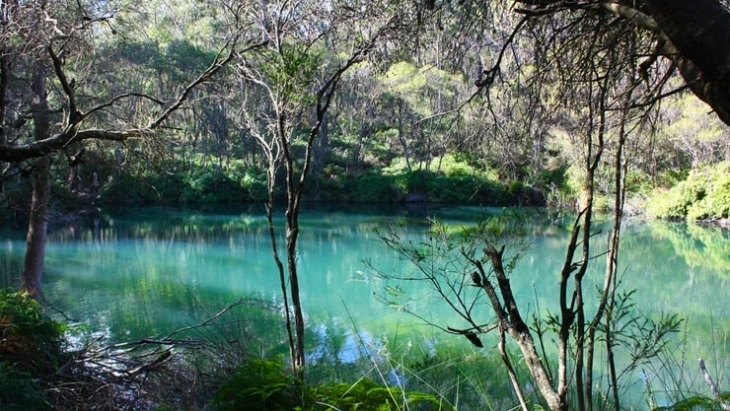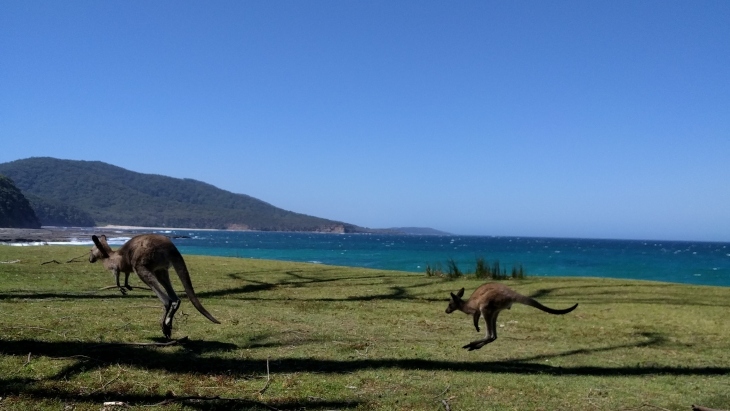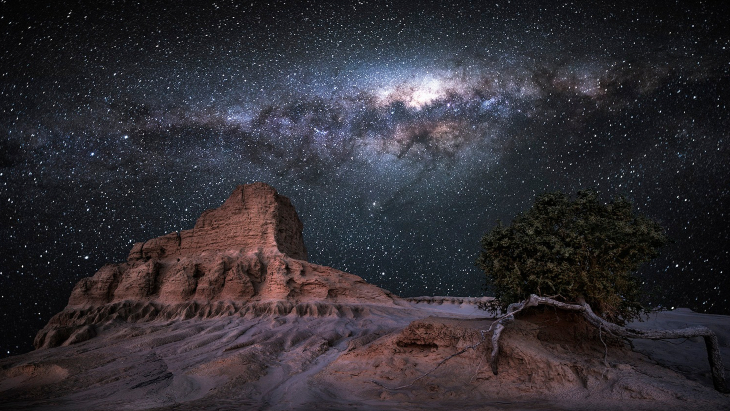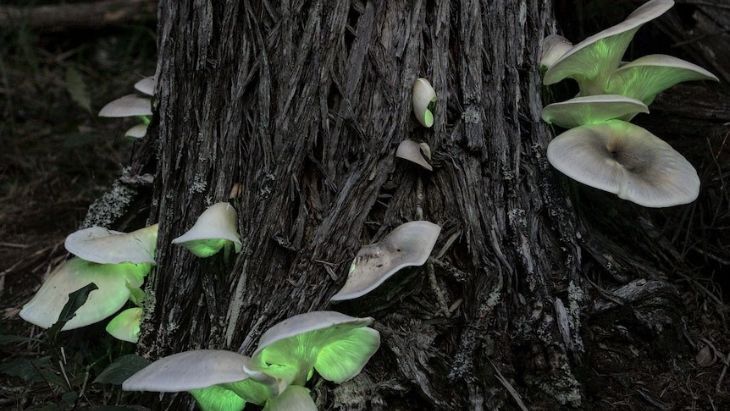15 Natural Wonders to Discover in NSW
- Toddlers
Preschoolers
Kids
Teens
Family

Put away that passport and pack up the car because beautiful NSW is calling your name! And if you’re keen to see Mother Nature at her finest, then you’re living in the right state.
Aside from our glorious coastline, NSW delivers natural wonders in droves. From curiously shaped rocks to bellowing blowholes, 'sea sparkles' and grand canyons, there are plenty of natural wonders in NSW, and some are just a short drive outside of Sydney. Get your cameras ready...
15 Natural Wonders to Discover in NSW
1. Camel Rock

NSW is known for having several curious rock formations, and Camel Rock in Bermagui is no exception - Camel Rock on the NSW South Coast looks eerily similar to a sitting camel!
It’s rumoured to be close to 500 million years old and was named during the first mapping of the NSW coastline. The giant camel sleeps right next to Camel Rock Surf Beach and is worth the five-hour drive to see it.
Location: Camel Rock Surf Beach, Bermagui
2. Glow Worm Caves

Who would’ve thought that a fungus could be so marvellous to look at! Yep, you read that correctly - fungus.
The larvae that ooze from fungus gnats in all their spectacular bioluminescence are what create magical glow worm caves, and they only exist in Australia and New Zealand.
There are three notable glow worm caves in NSW worth visiting – Lithgow, Bilpin, and Bundanoon. All three are a sight of amazing wonder, and run both day and night tours for the whole family.
Read more from our glow worm guide.
3. The Magical Blue Pool

Drive just two hours south of Sydney and you'll stumble upon the magical Blue Pool that needs to be seen to be believed.
Located at Carrington Falls in Budderoo National Park, the Blue Pool at Carrington Falls is a glowing natural watering hole that emits a stunning blue-green shimmer when the light hits it just right. Along with ogling at such a natural beauty, a day trip to Carrington Falls will reward you with stunning views, waterfalls, bushwalking opportunities, picnic spots, and even the chance to camp overnight - sold!
Location: 44-48 Hoddle Street Budderoo, Robertson
4. Belmore Falls

Few sights are more spectacular than a beautifully flowing waterfall. Lucky for us, NSW has plenty of waterfalls to gaze at, but one waterfall, in particular, is truly something special.
Located in the Morton National Park in the Southern Highlands, Belmore Falls cascade for an impressive 100 metres and land in a glorious pool of fresh water at the bottom. While we wish we could go for a dip in the freshwater pool, getting there is a 45-minute trek down an abandoned path that isn’t very safe for little ones. Several worthy lookouts give you spectacular views of the falls in all their glory and can be accessed via the Hindmarsh Lookout Track.
Location: Hindmarsh Lookout Track, Barrengarry
5. The Three Sisters

The three stunning sandstone formations are embedded in Aboriginal legend and represent three sisters ('Meehni', 'Wimlah' and 'Gunnedoo') who were turned to stone millions of years ago.
Three Sisters is an iconic Blue Mountains attraction and a great day out for the whole family, particularly if you choose to view them via the Scenic World Scenic Skyway.
Location: 23-31 Echo Point Rd, Katoomba
6. Bioluminescence

The seaside village of Jervis Bay on the NSW south coast boasts the whitest sand in the world and a stunning natural phenomenon in the ocean.
Incredible bioluminescence light shows are known to illuminate the water with 'sea sparkle' due to the thriving population of microscopic bioluminescent algae called Noctiluca. Most visible at night, chemical reactions beneath the surface cause plankton to become luminescent. The displays are unpredictable because of the underlying environmental conditions, but you are most likely to see this glowing spectacle in the warmer months, however, bioluminescence has been seen in Jervis Bay in July.
There have been three incredible Jervis Bay Bioluminescence events in 2018, 2019 and 2020 but spectators weren't so lucky in 2021. Bioluminescence has also been recorded along Sydney's Northern Beaches in 2022 and most recently in August 2023. It's incredibly hard to predict when and where bioluminescence will appear, however, Newport, Manly, and Freshwater beaches have had the same influx of bioluminescence for two years in a row - when and where will it pop up next?!
7. The Jenolan Caves

Unfortunately, the Jenolan Caves are closed until 2026 due to road damage.
Home to some of the most breathtaking natural rock formations in the world (that's right - the world!), visiting the incredible Jenolan Caves is definitely a bucket list item to tick off asap.
The Jenolan Caves are around three hours from Sydney in the Blue Mountains, so you'll probably want to make a day of it when visiting - luckily, there's plenty to see and do! Book one of the cave tours to get up close to the mega stalactite limestone formations and learn about their history (they're over 340 million years old!). Then you can stop off at the Jenolan Caves House Cafe for a bite to eat, followed by a visit to the Blue Lake, and a stroll along the Jenolan River Walking Track.
Location: 4655 Jenolan Caves Rd, Jenolan
8. Depot Beach

If you’re planning on road-tripping down the NSW South Coast, make sure you add Depot Beach to your itinerary. Nestled in the Murramarang National Park, Depot Beach is where you can see loads of kangaroos outside of a zoo or wildlife park setting.
Hundreds upon hundreds of kangaroos live in the National Park and come out to visit the shores of Depot Beach and neighbouring Durras, Pebbly, and Pretty Beach every day. There are a few great camping spots at Depot Beach if you want to stay overnight.
Location: Depot Beach, NSW South Coast
9. Kiama Blowholes

The roaring natural attraction in Kiama Harbour attracts close to 100,000 visitors each year, who come to ogle at the magical synergy when great plumes of water gather inside the harbour rocks with a bellowing whoosh! Along with the famous Kiama Blowhole, Kiama is also home to a second ‘Little Blowhole’ on Tingira Crescent just 3 kilometres south of the town centre.
Location: Kiama Harbour, Terralong Street, Kiama
10. The Walls of China

The Walls Of China is a collection of dramatic rock formations sculpted by wind and erosion in the most fascinatingly articulate designs. Dating back to the 1800s, the 40-metre-high dunes stretch for over 33 kilometres along the Mungo lakebed and are a sight to behold.
The best way to view the Walls of China is via the 10-kilometre cycling track that takes you across the stunning ancient Mungo lakebed. Guided tours are also available and run throughout the year.
Location: Mungo Foreshore Walk, Mungo
11. Sawn Rocks

Another naturally stunning rock formation, Sawn Rocks in Mt Kapatur National Park is the largest natural musical instrument we’ve ever seen.
While Sawn Rocks don’t actually make music, the dramatic formation of the 40-metre-high pentagonal basalt pipes looks exactly like a giant musical organ. The jaw-dropping rocks are the remains of lava flow from the Nandewar Volcano 21 million years ago.
Access to Sawn Rocks is an easy 15-minute walk through Mt Kapatur National Park.
Location: Killarney Gap Road, Narrabri
12. Capertee Valley

Capertee Valley is the second largest canyon in the world next to the Grand Canyon and is only 2.5 hours drive from Sydney near Lithgow.
Capertee Valley is an impressive 30 kilometres wide and boasts hundreds of impressive rock formations, stunning scenery, and an abundance of plant and birdlife. Pearsons Lookout gives you one of the best viewpoints of the impressive canyon and is easily accessible by car.
Location: Capertee National Park
Read our Capertee National Park guide for more information.
13. Dark Sky Park

Not only is Dark Sky Park the first Dark Sky Park in Australia but also in the Southern Hemisphere.
Thanks to the park’s crystal-clear skies, low humidity, and high altitude, the cosmos comes alive with thousands of spectacular stationary and shooting stars every single night.
Warrumbungle is also home to the largest optical telescope in Australia at the Siding Spring Observatory, which regularly runs tours during the school holidays. The best time to view the Milky Way and all the stars is of course at night, so if you’re keen to camp under the stars, there’s a range of campsites available.
Location: Warrumbungle National Park
14. Stockton Sand Dunes

We couldn’t run off a list of amazing natural attractions in NSW and not mention our glorious coastline, in particular, the Stockton Sand Dunes.
Located in the Worimi Conservation Lands at Anna Bay in Port Stephens, the Stockton Sand Dunes are sand on a very (very!) large scale. Stretching for 32 kilometres and towering 400 metres above sea level, Stockton Sand Dunes are the largest continually moving sand dunes in the Southern Hemisphere.
Aside from ogling at the impressive natural formation, sandboarding down the dunes is a favourite activity, or you can get really adventurous and book in on one of the many 4WD tours on offer. Whatever you do, make sure you bring plenty of water and sunblock as there’s not an inch of shade in sight.
Location: Stockton Sand Dunes, Port Stephens
Read our Stockton Sandboarding review for more tips.
15. Glowing Mushrooms

Head to Bournda National Park on the NSW South Coast, and cop a load of glowing mushrooms. Yep, you read that right—glowing mushrooms. Between March and August is considered the best time of year to find the glowing mushrooms, but locating them can be quite a challenge because the glow itself is quite subtle to spot.
Upon initial observation, the subtle light green glow may go unnoticed amid the darkness of the night. Yet, as your eyes acclimate, you'll discern it: bioluminescent fungi thriving in a cluster on a deceased tree stump, nestled in the heart of the Australian bush.
According to experts, it's an interaction between a compound in the fungi and oxygen and an enzyme that makes the shining light. Who knew?! Whether you're a mushroom fan or not, this is an incredible natural attraction in NSW!
Location: Bournda National Park, Bournda Rd, Wallagoot
More Natural Attractions in NSW
Mesmerising Mazes in NSW
Gorgeous Fruit Picking Farms in NSW
Cool Caves You Can Visit in NSW
Have you signed up to our newsletter? Join ellaslist to get the best family and kid-friendly events, venues, classes and things to do NEAR YOU!
Reviews


